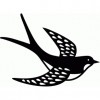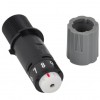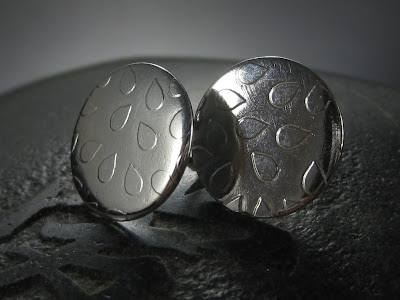Hi, Nadine here with a tutorial featuring two techniques for etching sterling silver and fine silver, including fired silver metal clay (PMC). In my previous tutorials, I focused on methods for etching copper, brass and steel, and whilst the silver can be etched in the same fashion, it needs stronger chemicals.
Traditionally nitric acid is used to etch silver, but this is a dangerous and toxic chemical and I for one am not comfortable using it! Instead, I will show you how to work with silver nitrate when electro etching and ferric nitrate instead of the Edinburgh Etch recipe that I shared for etching copper.
Electro Etching with Silver Nitrate
The set up for etching silver is exactly the same as my copper tutorial, but instead of using salt-water as an electrolyte, we use silver nitrate. Add 10g to 500ml distilled water to make a 2% solution. I bought mine from eBay and it cost £14.Silver nitrate can be used over and over on fine silver. When using sterling silver, the small amount of copper from the alloy water will turn the solution blue, see the photo below. This is normal and should still work well. It's worth noting that using some unusual alloys of sterling silver that are not just silver and copper, will contaminate the solution and limit it's lifespan.
Notice how the etched silver forms fern like branches on the scrap piece? They are fine silver granules and can be siphoned with a coffee filter and melted into balls for accents.
A Note on Safety and Storage
As with all chemicals add the silver nitrate to the water and not the other way round. Avoid contact with skin and eyes, wear rubber gloves and a mask too as it can be an irritant I can testify to this as I got a splash on my finger and the stain lasted about a week!Silver nitrate is light and air sensitive, so keep the mixed solution in a closed plastic or glass container in a dark cupboard.
It goes without saying that furry and kiddy helpers should not be near when you are etching metal.
Acid Etching with Ferric Nitrate
The Edinburgh Etch recipe I shared for copper, brass and steel will not work on silver. Instead I recommend ferric nitrate. Again, this isn't strictly an acid, but instead it's a safer corrosive which does not have noxious fumes and is not absorbed through the skin - that's not to say that caution shouldn't be taken of course, see safety guidelines above!Add 250g of ferric nitrate to 500ml of distilled water and use in exactly the same way as Edinburgh Etch. Place face down either propped or suspended so that the etched sediment can fall away. Once done, again neutralise your piece, and indeed the solution when you are completely finished with soda crystals.
Here is a snap of some silver that I etched with ferric nitrate. The vinyl seemed to contract in ever so slightly to stick remarkably well to the silver. It even held up against a rigorous wire brush cleaning! This meant that I got a fabulously clean etch.
Silversmithing Workshops
If you'd rather not etch at home, your local town may well have a jewellery workshop with these facilities. My one in Edinburgh has a variety of membership levels, from one hour ad-hoc, up to full-time bench hire. If you have all your pieces prepped and ready to go, you could make very good use of an hour or half day session.Disposal
Once you are completely finished with your etching solution, regardless of which technique you are using, you should take it to your local recycling centre to dispose.Final Product
DESIGNS USED:
 |
 |
PRODUCTS USED:
 |
 |
 |
 |











No comments:
Post a Comment